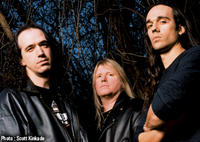Nile

Death on the Nile was Agatha Christie's classic 1937 whodunit novel (by coincidence she would later pen At Bertram's Hotel...). She couldn't have known how apt the title would become, for the American band Nile now are one of death metal's brightest lights. And unlike her book, Nile don't use Egypt as a mere backdrop, preferring to situate their ridiculously technical extreme metal in that cradle of ancient civilization.
The Egyptology angle comes care of Nile founder and front man Karl Sanders, who is something of an amateur expert on the subject. Sanders (who co-formed the band in 1993) studies ancient texts and hieroglyphics to glean his lyrical themes. This thread has run throughout all four Nile albums, but reaches its zenith on the recent Annihilation of the Wicked (Relapse Records). Thematically, this is in the same realm as Iron Maiden’s genre-defining 1984 album Powerslave, which drew on Egyptian themes, and Iced Earth, who delve deeply into American and military history.
The lyrics, which otherwise could be mistaken for common-or-garden death metal cliché if you didn't know the back-story, are complimented by extensive sleeve notes. A taster -"'Cast Down the Heretic' concerns the Pharaoh Akhenaten, who ruled Egypt from 1379 to 1362 B.C. The son of Amenophis III and Tiye, Amenophis IV changed his name to Akhenaten (which most likely means 'Servant of the Aten') in Year 5 of his reign indicating his allegiance to Aten (a creator god symbolized by the sun's disc)."
And so on and so forth... potentially leaving you thinking that if you wanted a history lesson you'd go back and repeat the fifth form for a third time. On the other hand, Egypt is fucking interesting, and this is certainly more vivifying than the usual deathly utterances. That is, unintelligible grunts won't get you far in life (which is kind of the point, this being death metal and all), and it's good to see someone exploding the envelope.
Good to see, and better to hear, because it's musically that Nile really impress. Death metal has always been a musical form that has attracted technical virtuosity, but this is getting out of hand. Nile are simply insane, knowing no boundaries, and virtually erasing all that has come before by absorbing it and processing it in new and vital ways. They redefine the death genre in the same way that Morbid Angel did 15 odd years ago, breathing new life into a moribund idea.
When Nile were touring with Morbid Angel on the back of 1998's debut album Amongst The Catacombs Of Nephren-Ka, Karl Sanders claimed that his band played "every single note as if it were going to be our last, and give every bit of strength we have within us every time we play." This is still the case on Annihilation of the Wicked, an album that spirals through monumental shifts of brutality and beauty, intensity and calm, the artistic and the arcane.
Sanders, joined here by fellow guitarist/vocalist Dallas Toler-Wade and drumming superhuman George Kollias, integrates Middle Eastern modalities and instrumentation into Nile's music. This is not overt in a tokenistic, look-we're-all-world-music-now kind of way, but in subtle and appropriate ways. There's an undeniable symphonic aspect to Nile's sound, wrought from Sander's obsessive meddling with the musical structures.
Ultimately though Annihilation of the Wicked offers a vicious assault on the senses, Nile’s main weapons being unbridled speed and proficiency. The counterpoint guitar work is astounding, ranging from distended chugging riffs to hyper-speed arpeggiation, mental thrash-outs to whammy-bar whackery. Kollias’ blast beats and syncopation put him right up with the best extreme metal skins men.
Nile’s musicianship has seen them recognized by the cognoscenti of the underground music media, heralding the band as the saviors of the death metal world. Mention must also be made of producer Neil Kernon, who has done a sterling job of capturing Nile’s twisted mayhem with clarity and depth, no easy task with music this unrelenting.
And, as with all Relapse Records releases, the packaging is stunning. This is an aspect that many labels sadly ignore. Relapse always have fantastic artwork that fits with the overriding theme of the music within. While it’s obviously not the most important thing, even more so with the digital realm stealing market share from hard media, it’s good to see a label that indulge their artists creative impulses across the entire spectrum.
Which of course suits a band like Nile perfectly. They’ve been called the Iron Maiden of death metal, and they definitely have the same kind of combination of image and substance that Maiden had in their heyday. Which means if you’re into extreme metal of any kind, then you owe it to yourself to check out this album.
Top 5
The Hurt Process – A Heartbeat Behind
Kraftwerk – Minimum Maximum
Meshuggah – Catch 33
Autechre – Untilted
Rhythm and Sound – See Mi Yah
Classic:
Sugar - Beaster















